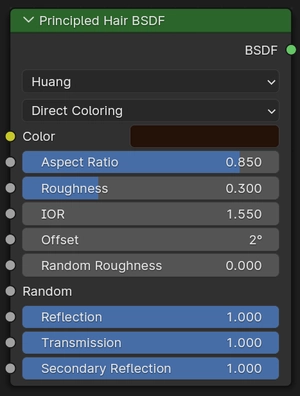原理化毛发 BSDF¶

仅限 Cycles
原理化毛发 BSDF 是一个基于物理的,易于使用的着色器,用于渲染头发和毛发。
Tip
逼真的头发应该在每条发股间具有些许差异。该着色器利用 随机色彩 和 随机粗糙度 来实现上述效果。实现方式是将 黑色素/粗糙度 的比值重新映射到
输入¶
通用选项¶
- 颜色
发股的RGB颜色。仅在直接着色模式下起作用。

使用直接着色参数化头发颜色。(顶部为RGB参数。)¶
- 黑色素
色素的绝对值。范围
Hint
这是对下面基础指数函数的线性映射:

黑色素。¶
- 黑色素红
褐黑素与真黑素的比例。范围

黑色素红。¶
- 染色
生成染发效果。不受随机化的影响。可以通过将颜色设置为白色来禁用它。
Hint
计算方式是通过将上面的 颜色 转换并添加到黑色素浓度的吸收系数中。

染色效果。黑色素值设定为 0.1,其余为RGB数值。¶
- 吸收系数
吸收系数
- IOR
折射率 (IOR) 定义光线改变方向的程度。折射率设定为1.0时,光线可直接透过;值越高,折射越强。默认值为
- 偏移量
通过增加头发角质层相对于发股的角度来倾斜头发的闪烁。人类的头发通常具有较低的偏移值。
- 随机色彩
对于每根发股,通过
Hint
黑色素浓度会与

随机色彩。¶
- 随机粗糙度
对于每根发股,通过
Hint
使用的公式与 随机色彩 中的一致。

随机粗糙度。¶
- 随机
产生随机数。如果没有与其它节点相连,则从 中获取随机数。
Chiang 模型¶
The Chiang model is based on a Gaussian distribution with separate roughness along and orthogonal to the hair.
- 粗糙度
指定在发干方向上平滑的闪光量。值过低会使头发平滑到看起来几乎是金属的,使闪光看起来像 光斑 ;而将其设置得太高将导致兰伯式的外观。

糙度。¶
- 径向粗糙度
指定在头发正常方向上平滑的闪光量。值过低会集中闪光;当它设置得太高时,光线会分散到线的宽度上。
Hint
从数学层面上理解为:该参数可以映射到逻辑分布的比例因子

径向粗糙度。¶
- 涂层
通过将粗糙度降低到给定的数值,来模拟第一次光反射(漫反射),进而模拟出一层闪亮的毛发。范围

涂层。¶
Huang 模型¶
The Huang model is based on microfacet based reflection and transmission, and supports elliptically shaped hair.
- 宽高比
The ratio of the minor axis to the major axis of an elliptical cross-section. Recommended values are 0.8~1 for Asian hair, 0.65~0.9 for Caucasian hair, 0.5~0.65 for African hair. The major axis is aligned with the curve normal, which can be created with geometry nodes, but is not supported in legacy particle hair.
- 粗糙度
Microfacet roughness for reflection and transmission.
- 反射
用于调制毛发表面的第一个灯光反弹的可选系数,此组成部分的颜色始终为白色。为了物理正确性,请保持 1.0 。
- 透射
调解组成部分的透明度的可选系数,拾取毛发内部色素的颜色,为了物理正确性,请保持1.0 。
- 二次反射
用于调节投射到毛发中的光线的可选系数,从毛发的背面反射并透射出毛发,并拾取毛发内部颜料的颜色,光线大致围绕入射方向定向,为了物理正确性,请保持1.0
属性¶
- 颜色参数化
该着色器共有三种 参数化 的方式来对毛发进行着色。
- 直接着色:
选择所需的RGB颜色,着色器会粗略计算必要的 吸收系数 (吸收系数详细说明见下文)。
- 黑色素浓度:
现实生活中,真黑素(在棕黑色头发中普遍存在)和褐黑素(红色头发)的数量和比例决定着毛发的颜色。该模式利用输入的 黑色素 数值来确定两者的数量,利用输入的 黑色素红 的值来确定两者的比例,进而实现对毛发进行着色。提高浓度会加深毛发颜色(下面的五个颜色示例都是在 黑色素红 设定为
白色(黑色素值设为
亚麻色 (黑色素值设为
淡红色 (黑色素值设为
棕色 (黑色素值设为
黑色 (黑色素值设为
设定好上述参数后,可利用 染色 输入项来实现染发的效果。
- 吸收系数:
指定由 Beer-Lambert law 定律确定的衰减系数
输出¶
- BSDF
标准着色器输出。
参考文献¶
This shader is an implementation of the papers by Chiang et al. [CBTB16] and Huang et al. [HHH22].
Chiang, M. J. , Bitterli, B. , Tappan, C. and Burley, B. (2016), A Practical and Controllable Hair and Fur Model for Production Path Tracing. Computer Graphics Forum, 35: 275-283. doi:10.1111/cgf.12830
d'Eon, E. , Francois, G. , Hill, M. , Letteri, J. and Aubry, J. (2011), An Energy‐Conserving Hair Reflectance Model. Computer Graphics Forum, 30: 1181-1187. doi:10.1111/j.1467-8659.2011.01976.x
Huang W., Hullin M.B. Hanika J. (2022), A Microfacet-based Hair Scattering Model. Computer Graphics Forum, 41: 79-91. doi:10.1111/cgf.14588